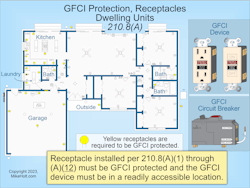
A ground fault circuit interrupter (GFCI) protects people from shock, while an arc fault circuit interrupter (AFCI) protects people from fires that could result from electrical arcing of wiring inside walls. Following the NEC rules will optimize protection, while noncompliance could prove fatal to occupants.
GFCI protection must be provided as required in Sec. 210.8(A) through (F). GFCI protective devices must be in a readily accessible location.
You can provide the GFCI protection using either a GFCI circuit breaker or a GFCI receptacle. To apply Sec. 210.8(A)(8) or (10), Sec. 210.8(B)(7), (13), and (15), the distance you measure from the sink or bathtub/shower is the shortest path the power-supply cord connected to the receptacle will follow without piercing a floor, wall, ceiling, or fixed barrier.
With the 2023 revision, the reference to windows and doors was removed to ensure GFCI protection for receptacles within the measured distance as required in Sec. 210.8 even if the measurement line passes through a window or door.
A GFCI circuit breaker provides ground-fault protection starting at the breaker, so the entire circuit has ground-fault protection. A GFCI receptacle provides ground-fault protection for whatever is plugged into it; it has load-side terminals that provide downstream protection for any other receptacle(s) or device(s) on the circuit.
Receptacles installed in the following dwelling unit locations must be GFCI protected — and the GFCI device must be in a readily accessible location (Sec. 210.24(A), as shown in Fig. 1).

(1) Bathrooms.
(2) Garages and accessory buildings.
(3) Outdoors.
(4) Crawl spaces (at or below grade).
(5) Basements.
(6) Kitchens.
Traditionally, this requirement applied only to kitchen countertop receptacles, but now any cord- and plug-connected appliance in the kitchen, such as the range receptacle, refrigerator receptacle, disposal receptacle, and microwave receptacle, now require GFCI protection.
(7) Food or beverage preparation or cooking areas.
(8) Sinks (receptacles within 6 ft of the top inside edge of the bowl of a dwelling unit sink).
(9) Boathouses.
The Code does not require installing a receptacle in a boathouse, but any that are in a boathouse must be GFCI protected.
(10) Bathtubs or shower stalls (receptacles within 6 ft of the outside edge of a bathtub or shower stall not installed within a bathroom).
(11) Laundry areas.
(12) Damp and Wet Locations Indoors.
Exception No. 1: GFCI protection is not required for a receptacle dedicated to fixed electric snow-melting equipment if the receptacle is not readily accessible and ground-fault protection of equipment (GFPE) is provided as required by Sec. 426.28 and Sec. 427.22.
Exception No. 2: GFCI protection is not required for a receptacle supplying only a permanently installed premises security system.
Exception No. 4: GFCI protection is not required for receptacles in dwelling unit bathroom exhaust fans unless specified by the fan instructions.
The receptacle for exhaust fans is internal to the exhaust fan. They are not accessible as a convenience cord-and-plug receptacle; therefore GFCI protection is not required. Per “UL Guide Information GPWX,” exhaust fans installed in the area directly above the footprint (width and depth of the equipment) of the bathtub or shower must be GFCI protected.
GFCI protection is required for 125V through 250V receptacles supplied by single-phase branch circuits 50A (or less) or 3-phase branch circuits 100A (or less) installed in the following locations [Sec. 210.8(B)]:
(1) Bathrooms.
(2) Kitchens.
(3) Food or beverage preparation or cooking areas.
(4) Buffet serving areas (if they have permanent provisions for food serving, beverage serving, or cooking). This requires GFCI protection for receptacles in the break area of a commercial occupancy.
(5) Rooftops.
(6) Outdoors.
(7) Sinks (for cord- and plug-connected fixed or stationary appliances within 6 ft from the top inside edge of the bowl of a sink). Note that a faulted appliance in proximity to sinks presents a shock hazard whether the receptacle is within 6 ft or not.
(8) Indoor damp or wet locations.
(9) Locker rooms.
(10) Garages, accessory buildings, and similar areas.
(11) Crawl spaces (at or below grade).
(12) Unfinished areas of basements.
(13) Aquatic tanks or bowls (receptacles within 6 ft from the top inside edge or rim, and receptacles within 6 ft from the conductive support framing of the container for aquariums, bait wells, and similar open aquatic containers such as tanks or bowls).
(14) Laundry areas.
(15) Bathtubs and shower stalls (receptacles within 6 ft of the outside edge of a bathtub or shower stall not installed in a bathroom).
Exception No. 2: Rooftop GFCI receptacles are required to be readily accessible only from the rooftop itself.
GFCI protection is also required for:
Exception No. 2: GFCI protection is not required for listed HVAC equipment, such as motor compressors or heat pumps (Fig. 2).